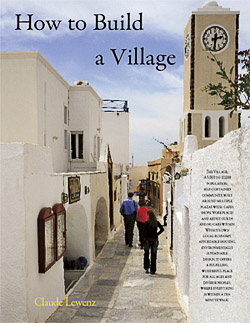
|
||
|
Issue 56 |
|
24 November 2009 |
|
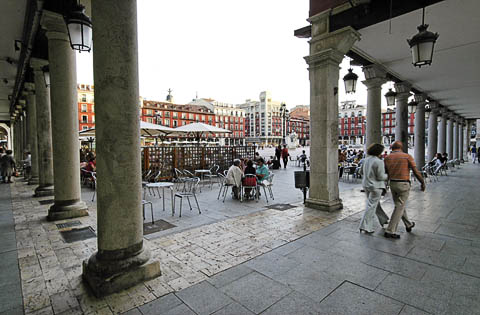 Valladolid, Spain The Plaza Mayor hosts several popular cafés. ©2005 J.Crawford AnnouncementsThe BooksCarfree Design Manual is now widely available in Europe and North America. The major on-line retailers seem to have the book in stock. Any bookseller in the English-speaking world should be able to order it. It is often discounted from the US$45.00 cover price. Carfree Cities is still widely available in paperback.World Carfree NetworkCarfree.com actively supports World Carfree Network [WCN]. They send the following news:Towards Carfree Cities IX to be hosted in YorkYork, a comparatively small city about midway between London and Edinburgh, will host Towards Carfree Cities IX between 21 and 24 June 2010. This marks the first time the conference has been held in the UK. A committed and experienced group of organizers is on hand.Carbusters Now On-LineWCN is releasing a new, on-line version of the venerable Carbusters. Have a look at the Carbusters.org web site. |
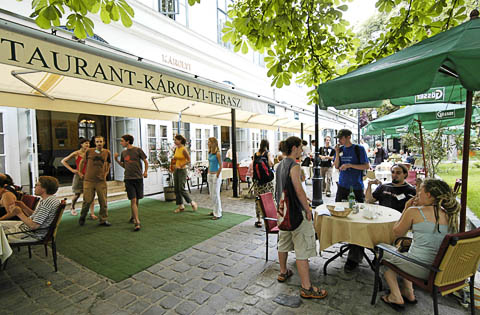 Budapest This friendly city has many fine outdoor cafés. ©2005 J.Crawford CafésThe sidewalk café is a great boon to city dwellers, especially when no cars shatter the quiet burble of people talking with their friends and neighbors. In this issue and the next we will take a photo tour of some European cafés.
News Bits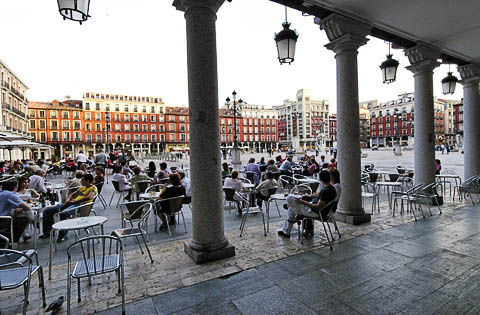 Valladolid, Spain The cooler evening air brings the locals to Plaza Mayor. ©2005 J.Crawford Putting China on RailsLike India's, China's passenger rail system has long been slow and crowded. But China is having a rail revolution. In just three years, the government will spend $300 billion on railways. The network is to grow by 20,000km, and of that 13,000km will be for trains traveling up to 350km/hr. China is going to get a lot smaller.The journey from Beijing to Taiyuan has already been slashed from 8 hours to 3. Last year, the 120km trip from Beijing to Tianjin was cut from almost an hour to 27 minutes. The journey from Wuhan to Guangzhou will shrink from 10 to 3 hours. The trip from Shanghai to Beijing once took 20 hours, is now 10, and will soon be cut to just 4. Train travel between China's two most important cities will suddenly compete with flying. Travel from Beijing to Guangzhou will be cut to 8 hours, compared with 20 today (and more than a day and a half by bus). This is a massive infrastructure project that will change the face of China. I believe that it is an acknowledgement by the Chinese government that highways and airways are not a sustainable course for China. Fast trains may help to spread economic development more evenly around the country. This in turn may bind the nation together and reduce the chances that China's internal divisions might one day lead the nation to fragment. The government hopes to stem the flood of internal immigrants to the coastal cities. There are, however, dangers of hypermobility, such as the first French TGV enabled between Lyon and Paris. The new passenger lines will also reduce congestion affecting rail freight by allowing unrestricted use of the old tracks for freight. The government plans to spend $40 billion on new freight cars in the next year(!). China already has nearly 40% of the world's total high-speed line length. Adding another 13,000km to this will give it nearly two-thirds of the world's total. Does anyone doubt that China is rapidly becoming the most powerful nation in the world? The USA, which was made a world power by its early and enormous investments in railroads, has no high-speed rail lines at all. Amtrak's costly and failed Acela experiment does not reach sufficiently high speeds to be considered "high speed" by usual definitions. Is anyone paying attention in Washington?
"The Shrinking of China" 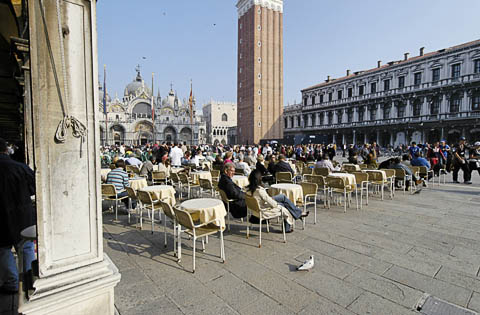 Piazza San Marco, Venice There are five cafés in this, the main part of the square. ©2005 J.Crawford France to "Save the human race"French President Nicolas Sarkozy will launch a carbon tax to fight global warming by reducing fossil fuel consumption. The proposal is writ large: saving the human race is its goal.In 2010, France will become the largest European economy to charge a carbon tax. France is following a precedent established in Scandinavia during the 1990s. The tax is a mere €17 per tonne of CO2 emitted and will be paid by both individuals and businesses. The money collected will be rebated, so the measure is revenue-neutral. Sarkozy announced the measure in a speech that warned of the need to fight climate change. Sarkozy said, "There are no reserves left. It's a question of survival of the human race." He aims to change French habits and to prepare the nation for a post-oil economy. The tax is aimed at actions that are damaging to society. He has compared the "historic" task of convincing the public to support the tax with other turning points in French history, such as decolonization and the abolition of the death penalty. Almost nobody is happy with the proposal, on either side. Good luck, Nicolas. You're going to need it.
"Sarkozy launches carbon tax to help "save the human race"" 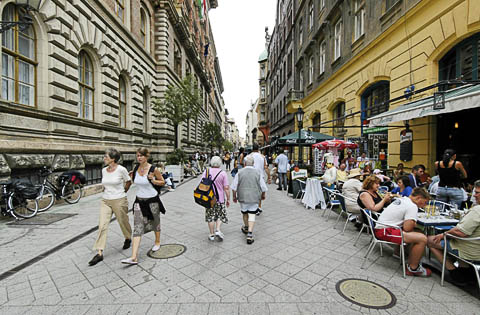 Budapest As in many places with short summers, people make the most of it. ©2005 J.Crawford Traffic Noise KillsIn Denmark, somewhere between 200 and 500 people die annually as a result of traffic noise. A recent Swedish study of 30,000 people confirmed what studies have long suggested: traffic noise raises blood pressure and increases the risk of heart disease, strokes, and blood clots."We have determined that at noise levels over 60 decibels there is a connection between high blood pressure in the young and the middle-aged and that it's an important risk factor in relation to heart disease and strokes," said Theo Bodin of University Hospital in Lund. Traffic noise is generally considered harmful when the average levels exceed 55-59 dB(A) over 24 hours. Levels above 65 dB(A) are especially harmful. The Swedish study shows that those aged 40-60 and young adults are most affected by traffic noise. Noise triggers a stress reaction, which affects the nervous system. This in turn causes the endocrine system to release stress hormones. That raises the pulse rate and blood pressure, leading to an increase in the risk of heart disease. Copenhagenize says, "A previous post. . . covers how traffic kills ten times more people than traffic accidents. Fortunately, we have cycling to tackle these issues."
"Traffic Noise Kills" 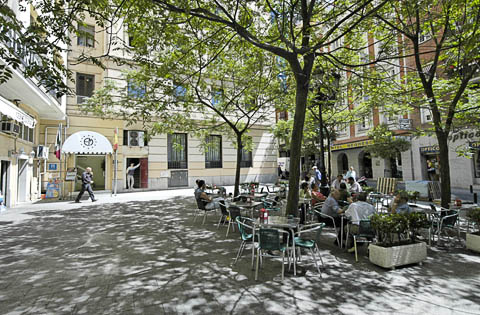 Madrid Summers in Madrid are hot. The shade trees are very welcome. ©2005 J.Crawford L.A. Cyclists in the Catbird Seat?Here you are, in the belly of the beast: Los Angeles, where autogeddon began. Imagine LA without cars. People walking and biking right in the middle of the streets, like they had every right to be there.Yes, the South American Ciclovia may be coming to LA. A group called cicLAvia, a coalition of bike advocates, transport experts, artists, and academics, wants to see Sundays in LA virtually carfree. This is nothing that hasn't already been done in other large cities, Bogotá, for example, but if it comes to LA, you know that the auto era really is drawing to a close. CicLAvia member Jonathan Parfrey says: This city is so park poor, and so car dependent. Air pollution is awful and childhood obesity is epidemic. But building new parks for people to get out of their cars and exercise can be prohibitively expensive. We want to create public space using the infrastructure we already have - our roads."It can be scary out there," says cicLAvia's Adonia Lugo: Los Angeles has a very strong bike culture, but I think the casual rider has the perception that this is a dangerous city for cycling. I think the best thing about a ciclovia is that it would give people a chance to try biking, without having to feel like they're risking their lives as soon as they leave the driveway.Parfrey admits that shutting down miles of city streets to traffic can't be done by a few volunteers. "This is something that will be impossible to pull off without involvement from the city." And members of cicLAvia met with Mayor Antonio Villaraigosa's office on 7 October 2009. Both sides were encouraged by the meeting. There are plenty who agree with Parfrey. The California Foundation, whose mission is to eradicate poverty in under-served communities, has offered $20,000 to fund a ciclovia in Boyle Heights. A footnote: Oscar Edmundo Diaz, a personal acquaintance, organized the first Ciclovia in Bogotá. Enrique Peñalosa, then the mayor, asked him how long it would take. He said six months. The mayor gave him six weeks. And he made it happen. The whole, entire city. LA is pussyfooting around with closing a few streets here and there. Still, it's a start.
"Imagine: L.A. bicyclists in the driver's seat, one day a week" 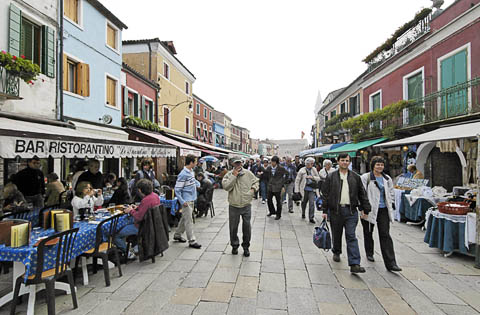 Murano, Venice The busy main street has many outdoor cafés. ©2005 J.Crawford Parking-Free San Francisco Bay AreaIt's a war zone out there. Parking-reform advocates keep a close watch on parking exemptions issued by the San Francisco planning commission. The city has been encouraged for years to tighten the parking-to-unit ratios in dense neighborhoods that enjoy good alternatives to driving. San Francisco is built the way it is because it was built at comparatively high density, with minimal parking. High-quality neighborhoods with real street life, such as the Mission or North Beach, would be impossible with the default 1:1 ratio of parking spaces to apartments.Developers often claim that it is impossible to get financing for new condo developments without providing more than one space per unit. They claim that banks will refuse to finance construction and units will be difficult for the original buyers to sell. But not all developers make that argument, and some have buildings that disprove it. "If you are doing a project next to BART or many buses, you really don't need to have a lot of cars," said Oz Erickson, a developer who has built more than 2000 units in San Francisco. His newest development, a rental building, will have an 0.5:1 parking-to-unit ratio. "It really works in those situations when the cost of excavation for an additional floor is really high and you're doing a rental project that has really good public transportation." He said that excavation and construction costs for a single parking space could run as high as $60,000, whereas the return on this investment is only $200/month. The additional construction time raises costs. He did admit that banks unfamiliar with the local culture are reluctant to finance projects with ratios below 1:1. He also said, "You really should be in a position where zoning laws do not require you to put in parking." On the east side of the SF Bay, some residential construction has omitted parking for decades. Patrick Kennedy has built infill buildings near public transport with very little parking. His website shows that he is unlike most other developers. The web site includes a quote from Lewis Mumford: "Cities exist not for the passage of cars, but for the care and culture of human beings." (Clicking on the photographs takes you to detailed pages about the projects, including before-and-after photographs.) "If you want to go after the densest configuration of housing, you have to not plan around the car," he said. "Spaces for cars cost a lot more to build than spaces for people because they chew up so much space." Kennedy himself lived carfree for four years when he was a student. "The best way to force [people] out of a car is to not provide them a place to park," he said. Amen.
"Some Bay Area Developers Ditch the Extra Parking Spaces for More Units" 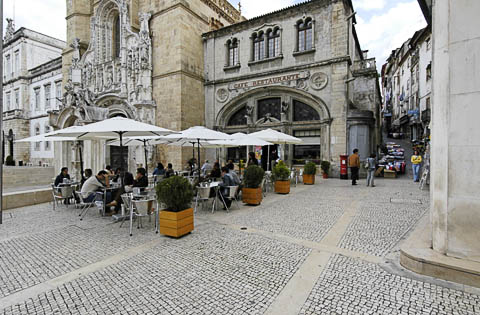 Coimbra, Portugal This gorgeous café sits next to an equally wonderful church. ©2005 J.Crawford Carfree Near D.C.Montgomery County leaders recently adopted a development plan that encourages carfree living. After weeks of debate, the county council unanimously agreed to offer financial incentives to developers who build dense developments near transit stations. They are required to build bike paths and walkways. Nearby shops and other amenities must be near by, and environmentally-friendly construction methods are mandated.This is a significant about-face. Most suburban regional plans expressly discourage development in congested areas, even those close to public transit. Instead, sprawling development in sparsely-populated communities is favored as a strategy to manage car traffic. Montgomery County actually has a population nearly double that of Washington proper. The council members finally acknowledged that it is foolish to continue to treat the county as just another suburb where driving is still a reasonable way to get around. The change comes as other jurisdictions around Washington are starting to embrace transit-oriented development. In some areas, the changes are coupled with improved public transport. Fees collected from developers are sometimes earmarked for public transport improvements. There is talk of building bus rapid transit systems, so buses do not have to compete for road space.
"Montgomery draws a car-free blueprint for growth 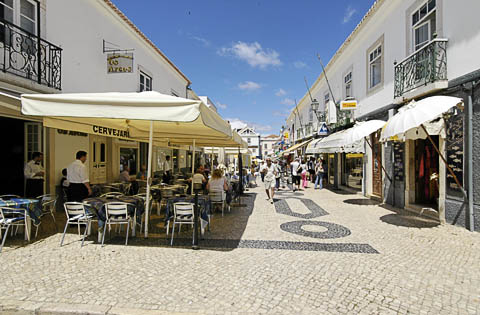 Lagos, Portugal This town near the west end of the Algarve bustles with foreign tourists. ©2005 J.Crawford Melt-DownAbsent major action to reduce CO2 emissions, global average temperatures will rise by up to 6°C (10.8°F) over the next 100-150 years, according a new analysis. The Global Carbon Project (GCP) says that emissions rose by 29% between 2000 and 2008, notwithstanding the Kyoto treaty. All of the growth came in developing countries, but a quarter of it came from production of goods destined to industrialized nations.The lead author of the report, scientist Corinne Le Quere, said: Based on our knowledge of recent trends and the time it takes to change energy infrastructure, I think that the Copenhagen conference next month is our last chance to stabilise at 2°C in a smooth and organised way. If the agreement is too weak or if the commitments are not respected, it's not two and a half or three degrees that we will get, it's five or six - that's the path that we are on right now.GCP uses almost all available data, from atmospheric observations to business inventories, to build a detailed picture of CO2 emissions, carbon sinks, and trends. Until about 2002, global emissions grew by about 1% per year. Then the rate increased to about 3% per year, caused mainly by rapid industrialization in China. It fell slightly in 2008 as a result of the global economic contraction - emissions are expected to fall by about 3% during 2009 and then resume their rise as the recession ends. The proportion of global emissions arising from deforestation has fallen to about 12%, as compared to 20% in the 1990s. This implies that there is only limited scope for rich nations to offset CO2 emissions by paying tropical nations like Indonesia and Brazil to halt deforestation. CSIRO's John Finnegan said: The developed world has exported to the developing world the emissions it would have produced had it met its growing appetite for consumer goods itself for the last two decades. In one sense, the developed world owns a large fraction of the developing world's emissions.Another of the analyses shows that per-capita emissions across the globe are rising. On average, each human now consumes goods and services that emit 1.3 tonnes of carbon, up from 1.1 tonnes in 2000. The GCP analysis suggests that limiting the global temperature increase to 2°C would entail reducing per-capita emissions to 0.3 tonnes by 2050. And that will be a challenge.
"Earth "heading for 6C" of warming" Feature Article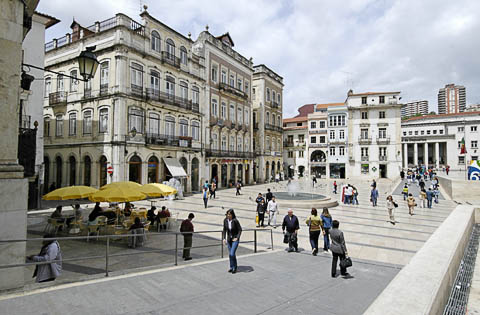 Coimbra, Portugal This ancient university town has several very fine squares. ©2005 J.Crawford First Steps in Carfree ConversionsJ.H. CrawfordWe consider here the need for dramatically improved public transport as one of the cornerstones of nearly every carfree conversion. A few cities are so small as not to need internal public transport, and a few others already have such good public transport that few improvements are needed. However, nearly every city needs a greatly expanded route network, more frequent service, and faster operations. None of this is difficult to achieve.Better Public TransportThe first change required is a change in attitudes. This must begin with the city government and include the public transport agency. In most places today, public transport is regarded as a second-class service for second-class citizens. This is why few people in the USA use it - everyone but the poor is expected to have a car and use it routinely. In a few cities, such as New York, the middle class does use public transport and reasonably good service is offered. More positive attitudes prevail in most of Europe.Public transport must become a first-class service. It must be safe at night, clean, operated by professionals, reliable, and on time. It should be free of all advertising. Recently, "bus-wrapping" (ads that cover an entire bus) and animated subway advertising have become common. This is yet another "second-class" stamp on public transport. It is accepted in most jurisdictions that people will have to stand during rush hour. It is thought too expensive to provide seats for all. With buses, any increase in seating capacity requires more buses and more drivers. However, rail systems can operate longer trains to provide more seats, without increasing the number of operators. A few rail systems have been fully automated, so operating labor costs fall to zero. Whatever is done, most people should be able to find a seat nearly all of the time. Sardine-packed conditions should never arise. One advantage of driving is the ease with which you can take along practically anything you wish. We will not achieve this level of convenience with public transport, but we can get close by making it easy to take along shopping carts and baby buggies. (If the system is fully accessible to wheelchairs, then it is also accessible to small carts.) This requires level loading, with the boarding platform and the vehicle floor at the same height. This also shortens station stops, because loading up and down stairs is slow. Level-loading can be provided with newer, low-floor buses and trams if boarding platforms just a foot (30cm) above the street are provided. Walking to the halt and waiting for a vehicle to come along are usually the two largest components of a trip by public transport. We need to bring halts to within about 500m (1600 feet) of every location in the city (the new standard for Beijing). This does not entirely solve the problem because the rider may not be going where the vehicle is, which necessitates a transfer. It is not practical to establish a route network in a large city that does not require an occasional transfer. However, we can hold transfers to a minimum and ensure that the actual transfer is quick and easy. This means short walks, no stairs, and short waits for the next vehicle. The best route network is usually a hub-and-spoke arrangement, with transfers occurring mostly in the downtown area, where service is concentrated and vehicles arrive frequently. This also implies the need to concentrate the most common activities at the city center (or to situate them in every neighborhood, as with grocery stores and elementary schools). Good public transport service is too costly unless the population is clustered around relatively few halts. There is otherwise not enough demand to justify frequent service. The Reference Design for carfree cities concentrates a million people into 100 districts in which the public transport halt is no more than 380m (1250 feet) away. The necessary density was usual in most cities less than a century ago and can still be found in many cities. High density became unbearable in the USA during the 1920s, when private cars usurped huge amounts of space for parking and movement. At the same time, cars imposed a great burden of noise, pollution, and danger. This is why, after WW II, American cities rapidly dispersed into low-density, auto-centric suburbs, a pattern now common around the world. Good public transport is impossible in the suburbs. Service-quality considerations dictate the choice of rail systems over bus systems whenever possible. The quality of service is much higher with rail systems, and it is now clear that people perceive the difference. As I once said, half in jest, "Nobody with a choice ever took a bus anywhere."
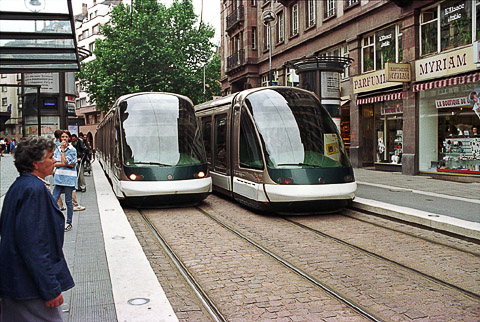 Strasbourg Modern low-floor-trams are quick to board from low-level platforms. ©1997 J.Crawford If surface-running rail systems are chosen, they must be installed on their own rights-of-way, where they never compete with cars for road space. When Zurich decided not to build an underground metro but to fix its trams instead, the first change was to move cars out of the places where they blocked trams. The choice between trams and metros is argued endlessly, and the subject is complex. However, in cities with populations over about one million, at least a few metro lines are almost essential, as only they can provide rapid service over the longer distances that large cities entail. Trams can provide supplementary, lower-demand service in big cities and can be the principal mode in smaller cities. The smaller trains are actually an advantage given the lower levels of demand.
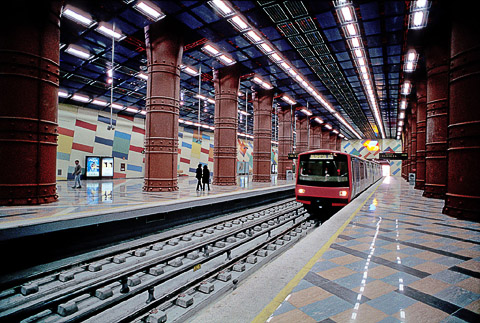 Lisbon Lisbon recently built this attractive, state-of-the-art metro. ©1999 J.Crawford Capital costs of new metros in existing cities are extremely high, whereas tram systems can be installed comparatively cheaply. However, when demand warrants the high capacity of a metro, it can still be cost-effective due to the comparatively low per-passenger operating costs. A further advantage of the metro is that it can reach very high speeds on its protected right-of-way. Trams can exceed 50 km/hr (30 MPH), but urban surface vehicles should not travel faster due to noise and safety issues. Very large cities need limited-stop regional rail service. Consider the RER in Paris, which links the suburbs with a few major stops in central Paris. New York runs express trains that serve a similar function. Once again, it is a question of speed. Local trains making many stops achieve quite low average speeds, which makes longer trips tedious. If we are to ask people to abandon their cars, then public transport must be available at all hours of the night. Many larger European cities have buses that run at least once an hour during the night, and New York's subway never quits. Some level of night-time service is nearly essential. Route planning is usually a tiresome chore for passengers. It can be surprisingly time-consuming and difficult to find a route to an unfamiliar destination. The Dutch have an excellent nationwide system that will plan any trip you can make by public transport (which is nearly all of them). I found it reasonably easy to use and highly reliable. This kind of Internet service is moderately expensive to establish but cheap to operate. It is a hallmark of a first-class system. Likewise, information should be available at tram and metro halts regarding the time until the next vehicle arrives. This is complex to implement but has been done. This allows you to run an errand when you discover that you have a few extra minutes before the train arrives. Faster ServicePublic transport service must become much faster than it is today. Ideally, it should be faster to take transit than it is to drive, which makes it much easier to persuade people to give up their cars. A number of conditions must be met.Transit managers need to speed journeys. Seconds count. This is not the current attitude at most systems, where service is considered acceptably good if trips run less than five minutes late. But fast service can only be achieved if every aspect of operations is considered from a time perspective. For instance, it would be common in many systems to order new trains without carefully considering how long it takes to close the doors and depart. "Only" five seconds might be saved here, but even on a journey of moderate length, that can save the passenger a minute. When millions of trips are made every day, it adds up to a lot of saved time. Increases in top operating speed have a smaller effect on stop-to-stop time than might be supposed, but it is still important. Metro trains should routinely reach speeds of 100 km/hr (60 MPH), even though they may remain at that speed for a fraction of a minute. Most of the energy can be recovered through regenerative braking. More important is the achievement of high acceleration, which has a pronounced effect on stop-to-stop times. Research in the 1930s showed that quite high acceleration is tolerable, even for standing passengers, if it is smooth. Peak acceleration should take about one second to be reached, without any jerks. As long as this is accomplished, acceleration somewhat above 0.2 G is acceptable. Even some modern trams only reach 0.1 G, which significantly reduces average speeds, but the PCC streetcar of 1935 achieved peak accelerations of 0.22 G. Keep the vehicle moving. Station dwell times are a large part of total time. It should be possible to open doors on both sides of the train to allow faster boarding. If one side is used for disembarking passengers and the other for boarding, times are still further reduced, and there is less jostling for the passengers. Fewer stops make for much faster service. This point is rarely appreciated. Cutting out a halt saves not only the time that the vehicle is stopped but also the time lost to braking and acceleration. Buses are chronically affected by this problem - they'll stop almost anywhere. Good practice keeps the halts at least 400m (1300 feet) apart, and 700m (2300 feet) is better. Reducing the number of stops also makes the journey more comfortable. Each district must have only one, centralized halt for a given route. Finally, fare-free transit is worth serious consideration. We will not go into the details here, but it saves a lot of time, money, and aggravation for the passenger, which makes transit a more attractive option. Editorial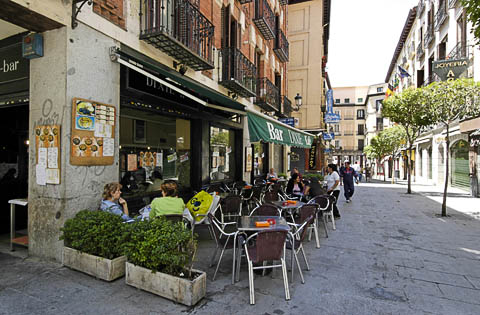 Madrid The city has relatively few carfree spaces, but they are excellent. ©2005 J.Crawford Youth and Our DebtJ.H. CrawfordI am going to begin addressing young people directly. I mean those who have reached the age of mature thought (which begins in a few children as early as age eight) and younger than, say, 25. The members of that generation are going to bear the brunt of our terrible mistakes of the past century or so. Whatever else happens, peak petroleum extraction will certainly occur during their working lives, perhaps before they have finished school, and possibly a year or two ago.It now seems likely that nothing will be agreed at Copenhagen this December except to delay agreement by a year. . . or more. At the same time, many of the measures being touted as solutions to greenhouse gas emissions, such as "clean" coal and carbon sequestration, are nearly as bad as the bankrupt policies they are slated to replace. The powers that be (i.e., the rich) want to see as little change as possible. They fear, probably quite rightly, that their capital investments will be worth less if the status quo changes. Fear of change is an easy fear to stoke in a frightened people, and I think many people in most lands are now frightened, even if they are not precisely sure of what. And the problems we face have a way of becoming more daunting the better we know them. The savage and mindless politics of the USA make meaningful change extremely difficult. Take for instance the current health-care legislation. It seems unlikely that the root causes of the health care problem will be addressed: bureaucratic inefficiency, money grubbing, over-treatment, and medically-induced disease ("iatrogenesis"). The insurance industry is deemed too large to suffer, which any real solution demands. Private interests will rule the debate. In similar fashion, climate change will be ignored for as long as that is possible. Oh, there may be some window dressing, in the form of modest improvements in vehicle fuel efficiency and a few wind mills here and there, but nothing significant will be allowed to change until change imposes itself. What happens in the USA is important beyond its borders for the simple reason that the nation is the leading emitter of greenhouse gases (if you count the goods we consume from overseas producers). The profligate American way of life, made possible by oil during the past 150 years, will have to change. I believe that this change can bring with it a better life for nearly everyone but the very rich. I think that good change will necessarily occur in the context of increasing social justice. The trickle-down theory will have to be abandoned in an era of increasing material scarcity. Not only are we leaving you, today's young people, with empty cupboards, we're also leaving you to settle our bill. Between now and 2019, the US national debt is projected to increase by $9 trillion. Of that increase, $4.8 trillion is interest on the debt. This is the beginning of runaway debt, which usually augers for massive inflation. When a society can no longer pay the interest on its debts, that society is functionally bankrupt, even though the wheels may continue to turn for a while. I have no doubt but that a concerted effort to reduce spending (in healthcare and military opportunism, for instance) and raise taxes on the rich, which as recently as 1963 still reached a marginal rate of 91% on incomes above $400,000 in the USA, could avert disaster. After all, it is not so many years since Bill Clinton left George W. Bush with a huge budget surplus, which the latter squandered in remarkably short order. The problems are large, but solutions exist. What's lacking is the will to take action. That's where young people come in. First, a bit of history. In 1965 it looked as if the world had reached a permanent stodgy condition. Nothing would ever change again. By 1969 everything had changed. My generation can take the credit, and also the blame for the changes that proved not to be such a good idea. Young people have a power they do not realize. The really are the hopes and dreams of their parents and grandparents. There may be strife between generations, but the elders really do want to see their children live a good life in a good world. They will listen to you. Your arguments will have to be good. They must be passionate. You may even have to listen to "reason" calmly. Your task is, in this case, not as difficult as it may seem. My generation does know that the world in general, and the USA in particular, is in a dire mess. In the Western democracies, only the generation now dying off has the experience of true adversity. They are the generation who survived the privations of the Great Depression, only to see that followed by the most terrifying war the world has ever known. Their early lives were exceptionally difficult and dangerous. Once the war was over, things improved rapidly. In the USA, my generation had its trials and tribulations, mostly in the form of the senseless and intractable war in Vietnam. We had our ideals (peace and love), and later our concerns with just making a living and raising a family, a task which seemed more difficult once it was undertaken. I'm not sure we actually lost our idealism, but we lost our willingness to do much about it. We're old now (nearly), and many of us are tired and dispirited. We've seen a lot go down, and some of it was pretty bad. Many of our heroes were murdered. And so it falls to you, dear children, to take up the mantle. And on the basis of my more than 60 years of experience, I will presume to offer some suggestions about the strategies you might adopt. First, I would urge you to read Saul Alinsky's Rules for Radicals, which really should have been called "Rules for Effective Radicals." Alinsky was clear that effective action was, of necessity, fun and funny. Alinsky was not a scold. He simply told how to get noticed and cause change. He gave many examples of actions that worked, and had everyone laughing along the way. So, be creative. Have fun. Make us all laugh at ourselves. Second, it's time for you to lean on Barack Obama. You got him elected. I think he knows the right things to do, but he is a master of the art of the politically possible. It's your job to shift the impossible into the realm of the possible. My generation eventually stopped a war on the Vietnamese. Your job is to stop a war on the very Earth itself. I want to close with a warning. Be careful with whom you associate. Stay away from the scary people. Some of them are going to be agitators and informers and other unsavory types. They may try to steer you away from your determination to seek peaceful, if noisy, change. The right wing, obsessed as it is with preserving the situation that has made some of them rich beyond imagining, will stoop to practically anything to stop you. Just stay out of their way. If you want to know what these nut cases are capable of, just read a history of the Watergate scandal and its cover-up. Those same scary people are still around, or their progeny.
We've left you with a basket of problems. Just keeping everyone on Earth eating is going to be a real challenge. But I'm certain that solutions to our problems do exist. I've spent most of a lifetime trying to see some of them achieved. Keep the faith, be creative, and have fun. And I'll be happy to join you in your quest.
Letter to the Editor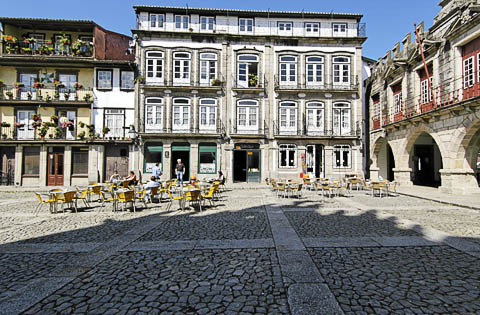 Guimarães, Portugal Not many tourists get here, but this old stone city is worth a visit. ©2005 J.Crawford Your comments on the need to make eco-towns carfree are apt - after all, the idea is that people moving to live in an eco-town accept the need for various eco-activities, including reducing sharply the need for cars - as long as the transit access is reliable (including no strikes), otherwise the eco-town becomes an open-air prison. As a transport planner, I'm not convinced by your comparison between streetcars and buses. It looks more like a comparison between streetcars and diesel buses. As one example: "9. Streetcars don't smell like diesel." Neither do trolleybuses and some other advanced buses. The two main differences between streetcars and buses are 1) that streetcars move more predictably than buses, and are much safer in pedestrian areas and 2) that streetcars cost so much more than buses, that under the current fiscal rules putting in streetcars often means damaging the bus service, where buses typically provide many more trips than streetcars do. The story in Edinburgh is that the tram project has run over budget so much that money will have to be taken from the buses. It is, of course, an interesting question as to whether the current fiscal rules are correct. If we want a 10% modal share for local transit, the budget in the UK should be something like £3000/yr/car x 30 million cars x 10% = £10bn/yr. The UK doesn't spend anything like that amount every year. Even if we spent a fraction of that, we could replace dodgy old diesel buses with clean buses. We don't seem to have the money for that, either. I'm also not convinced by your approach to removing cars from the road. I can't see anyone buying that plan, particularly the congestion charging and parking restrictions. Unless you intend to charge for private car parking outside warehouse stores, it will damage the independent store-keepers even more than they have been hitherto, as they rely on street parking. The correct approach, as I see it, is to reduce the speed limit to 20 mph in all parts of the urban area, from the typical UK speed limit of 30mph. The lower speed limit means that a lot of inefficiency in junctions can be removed, and the extra delay on the roads is counterbalanced by reduced delay at junctions, especially during rush hour. At best, during rush hour, it will save car drivers a lot of time. At worst, it would cost one minute a mile, not much when ITV shows an hour of Coronation Street every night (which says a lot about how valuable people's time is anyway). At 20mph, we can have more cyclists and pedestrians, further reducing congestion, and providing opportunities for innovative lightweight vehicles. Not exactly carfree, but painlessly carlite, and likely to become more so year on year.
Regards,
Francis King MA MSc MIHT Transport Planner
Editor's ResponseIn the first place, the comparison between trams and buses is not mine, although I pretty much agree with it. Second, yes, I did ignore the trolley bus, which is not all that common in practice. I have said in other venues that trolley buses are excellent in hilly places such as San Francisco. What I don't like about them is that they require twice as much wire as trams and complex switches at junctions. The poles are prone to coming off the wires, which stops the bus until the driver resets them.In fact, I am an active proponent of wireless trams, as I don't like any amount of wire cluttering up the sky. If wireless electric trams and buses can be developed (and I think this is pretty certain by now), then we have removed one of the great costs of new public transport service. Laying rails is not all that expensive, and low-level platforms for trams are cheaper than the high-level platforms that still seem to be required by BRT. And you still have all the advantages of rail service. What is needed is to remove subsides from private car use. This will raise so much cash that we then have the option of either fare-free transport, which is more convenient for the user and has lower total operating costs, or transport that pays for itself from the farebox at rates that are quite a lot higher than now but still much lower than the cost of driving once subsidies are removed. As far as parking is concerned, yes, I would propose to tax all public parking, which actually alters the balance in favor of local merchants, who can operate with little or no parking, whereas big-box stores certainly cannot survive without huge parking fields (which are paid for in part by the few people who use these stores without driving to them). Practically anything that lowers the speed of cars is fine in my book. See my Agenda for Barack Obama (the bullet points in the section Short-Term Changes). |
|
Books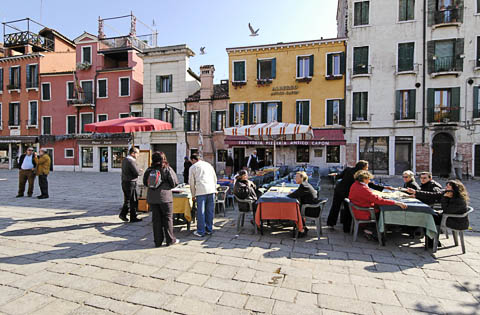 Campo Santa Margherita, Venice This large neighborhood square sees heavy use by the locals. ©2005 J.Crawford This issue has only a single book, but it's one of the most important we have received recently.
I finally go my hands on a copy of this book. It parallels my own Carfree Design Manual in many ways and diverges in other ways. Most of our differences relate to means, not to ends. Lewenz thinks we should live in the same kinds of urban villages that I do, and his vision of what they should look like is quite similar to my own. We share the notion that a high quality of life can best be had in a relatively dense urban setting, free of cars. The book is printed in full color throughout and carries many good photographs of urban areas. There is some overlap with my own travels and photography, but I have not been to Greece, which Lewenz draws upon at some length. I will review this book soon, but I wanted to get a capsule notice of it in circulation as soon as possible. It is obviously a significant contribution to the literature. The book is available from Amazon.com in the USA, Canada, and the UK.
Hot New Links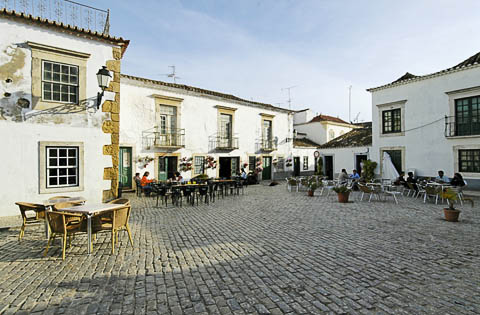 Faro, Portugal This, the principal city of the Algarve, has some excellent squares. ©2005 J.Crawford The links below will open in a new browser window:
KBOO with Bill Resnick Podcast MP3, 2 November 2009 Los Angeles: the bike culture today, by Richard Risemberg Where We Want To Be: Home Location Preferences And Their Implications For Smart Growth [PDF!] from VTPI Economic Impact of Public Transportation Investment [PDF!]
About Carfree Times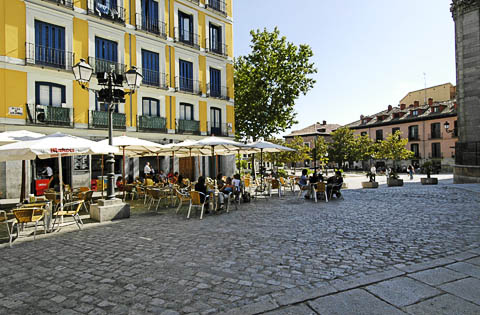 Madrid Later in the day, the heat is tempered by shadows cast by nearby buildings. ©2005 J.Crawford Next Issue
Subscribe to Carfree Times
Write for Carfree Times
Statement of OwnershipCarfree.com is wholly owned by Joel Crawford, the legal name of author J.H. Crawford. Its operation is financed by J.H. Crawford, with the help of some generous donors between 2004 and 2008. It generates no revenues directly but does help support book sales. Carfree.com accepts review copies of books but makes no commitment to review them. J.H. Crawford receives no commissions from the sale of books mentioned on Carfree.com. The views expressed at Carfree.com are those of J.H. Crawford, except for articles, letters, and editorials that carry the names of other authors. The inclusion of these signed texts is at the sole discretion of J.H. Crawford, who does not necessarily agree with the views expressed. All other content, except quoted material, is written by J.H. Crawford. E-mail announcements of new issues of Carfree Times are mailed to approximately 850 subscribers. A rough estimate of first-year circulation for each new issue is 5000. All the issues ever published are still being read. Carfree.com as a whole served 1.43 million pages and 119 GB of files in the 12 months ended 31 October 2009. |
| Editor | J.H. Crawford |
| Send e-mail | |
| URL | http://www.carfree.com/
|
Back to Carfree.com
Carfree Times Home
Back to Carfree Times Issue 55
Forward to Carfree Times Issue 57
E-mail
carfree.com
Copyright ©2009 J.Crawford
